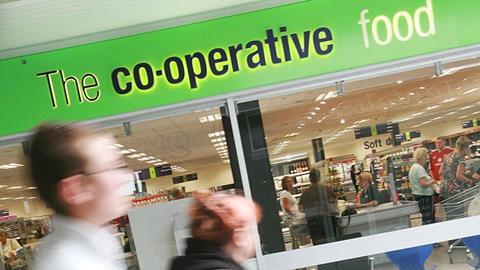The Co-operative Group isn’t just facing the usual technology challenges this year – as well as running normal IT projects, it’s busy integrating its entire business with Somerfield, which it bought in 2008. Rebecca Thomson speaks to food retail IS director Mark Hale about his plans

What the Co-op has done so far
- Converted up to 24 Somerfield stores a week to Co-op branches
- Started rolling out Somerfield’s central replenishment system to all its stores after re-platforming it to fit 4,000 stores
- Introduced a programme to enable both companies’ products to be sold in every store
- Started mulling its multichannel and mobile strategies
- Worked on rolling out more kiosks and self-service tills
- Started work on reducing the number of depots used from 32 to 12
- Started work on consolidating four warehouse management systems into one
Integration projects are not easy – they’re often big, difficult and expensive – but they’re also unavoidable, especially if your company happens to have recently bought another business. Mark Hale, food retail IS director at the Co-operative Group, is in the middle of one of the biggest – linking up Somerfield’s old systems with the Co-op’s, taking the best bits from each and positioning the company for growth. It’s not a simple task, but it’s one he’s relishing.
“We’ve had to focus our efforts on the integration, and not get distracted with other initiatives,” he tells Retail Week. “The sheer scale has been a challenge – we’ve converted nearly 700 Somerfield stores in 12 months. It’s become almost normal in the Co-op, but I don’t think it’s normal elsewhere.”
Cautionary tales abound after the other big grocery merger of recent years, Morrison’s and Safeway, highlighted a few things to avoid. Morrison’s initial approach was to throw away much of Safeway’s fairly well-advanced infrastructure and roll out its own systems in every part of the business. While the company’s IT is now starting to rise from the ashes, it ended up requiring a costly overhaul to get the systems to the stage they need to be at, and the Co-op is keen to avoid the same mistakes.
“The sheer scale has been a challenge”
Mark Hale, Co-operative Group

“Our principle was to take the best of both businesses,” says Hale. “Right from the start we were very upfront with people. It helped us and Somerfield understand we weren’t bulldozing in, switching everything off and putting Co-op systems in.”
This meant picking the best of what Somerfield had to offer and adapting it to the newly merged business. Some of Somerfield’s IT was quite old, Hale says, because its private equity owners stopped the company investing in technology, meaning it had to focus on the core business. Much of it had also been outsourced to Tata Consultancy Services, with only a small IT team in-house to keep control of strategy.
But it still had a few gems, with the Co-op deciding to roll out its central replenishment system to help the newly-combined business better predict demand and manage stock.
But rather than simply rolling out Somerfield’s system, the company first had to put the Co-op’s own ordering system into every store to make sure integration timelines were met. It relies on sales history to determine how much of a certain product should be ordered, as opposed to the new system which forecasts demand and can be co-ordinated centrally.
“Before the acquisition we had 2,220 stores and they all had different ways of ordering,” says Hale. “There is a consistent method, but it is cumbersome and disjointed and while some are really good some find it a challenge.
“At the moment if we know it’s going to be sunny at the weekend we have to rely on the store team to order additional products like ice cream and order enough – moving forward the system will do this automatically,” says Hale. Under the new system promotions and ordering will be managed centrally.
Challenges
Before Somerfield’s system could be rolled out, it had to be re-platformed onto more modern technology, integrated into other Co-op systems, and scaled up to make sure it will work for up to 4,000 stores. Once the work was done, roll out began and Hale says it will be in all stores by the end of this year.
Such a big integration project is bound to have its challenges, and Hale says one of the biggest has been keeping the Somerfield systems going while either integrating them into the Co-op or decommissioning them. He pays tribute to the Somerfield team, who, he says, have stayed motivated throughout despite going through a difficult time. “They’ve done a cracking job. It can’t be easy if your world is collapsing around you, but the end is in sight.”
Plus, of course there’s been the speed at which the Co-op has converted Somerfield stores, moving at an average rate of three to five stores a week but reaching 24 a week on occasion. The tight timescale was partly to help Somerfield head office staff, some of whom will be leaving the business, and partly to reduce confusion for consumers.
And while combining two sets of stores into one is tricky, combining two supply chains is even trickier. Somerfield stores had to be able to communicate with Co-op depots, ensuring they were still able to order products. To achieve this Hale’s team wrote a programme that converted product codes so they could work across different systems. This allowed Somerfield stores to keep ordering products as they went through the migration process. The project went live in June 2010, enabling Co-op to use Somerfield and Co-op products interchangeably as stores were migrated onto the Co-op systems.
But, Hale says, even despite these hurdles, the integration is going as planned and will finish in June this year. The key to the success so far, he says, is simplicity. “The one thing I’d do again is keep it simple and make decisions quickly,” he says. “Keeping it simple enables you to keep up the pace of delivery.”
The next chapter
What comes next for technology at the Co-op? Hale has plenty of plans, despite the integration work keeping him busy. The company is working on its multichannel and mobile strategies this year, although he says there are no current plans for selling groceries online and it is particularly keen on self-service tills and in-store kiosks. Hale says kiosks that enable a customer to pay for their shopping in-store and then have their basket delivered home have increased the average basket size from £9 to £55, and there are plans to roll them out to more stores.
The company also wants smaller self-service tills, is replacing 1,600 manned checkouts, and is rolling out 3,500 handheld terminals this year. It is also one of the few big retailers set to try contactless payments, with trials due to start in September, and Hale is optimistic about the results.
Not only are there plans afoot for new store IT, but systems in the background are working hard too. The grocer is moving from using 32 depots to 12 in three years, and is consolidating four legacy warehouse management systems into one. Even with the integration being a priority, work has continued. “We’ve kept certain things going, but at a slow pace. We haven’t lost the projects we wanted to deliver but integration activities have taken priority.”
Over the next couple of years, he adds, Co-op – like a lot of retailers – needs to do a lot of work on its supply chain systems. It has legacy systems to replace and a multichannel offer to focus on. But, Hale says, as with any busy IT department at a major retailer, the focus will continue to be on customers and how technology improves their experience.


























No comments yet